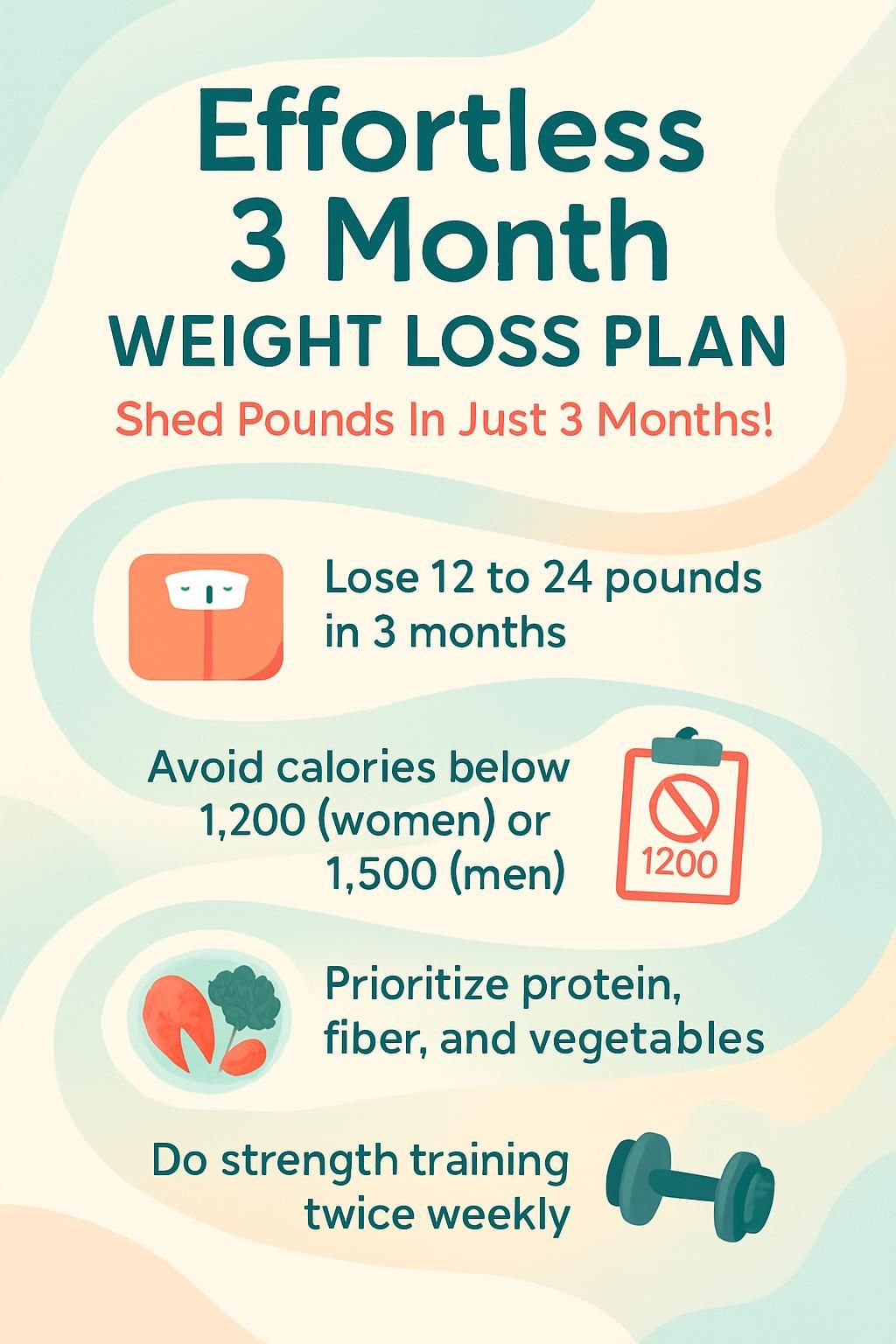Effortless 3 Month Weight Loss Plan: Shed Pounds In Just 3 Months!
Our Nutrition Assistant AI Suite will transform your body. You will lose fat, get toned, and build muscle. Gain confidence and optimal health.
You want clear results without feeling starved or worn out. Healthy weight loss happens at a steady pace, not an extreme one. Experts recommend 1 to 2 pounds per week, which can mean 12 to 24 pounds in a 3 month plan.
This guide shows you how to set goals, pick safe daily calorie targets, and build habits that last. Small steps build momentum. Follow the plan, and progress can feel simple.
Key Takeaways
- Losing 1 to 2 pounds per week, about 12 to 24 pounds in three months, aligns with CDC guidance for safe, sustainable weight loss.
- Set realistic goals with healthcare support. Avoid daily calories under 1,200 for women or 1,500 for men due to health risks.
- Build meals around protein, dietary fiber, and vegetables. Cut processed foods and sugary drinks to manage hunger and support fat loss.
- Combine strength training 2 to 3 times weekly with at least 150 minutes of cardio to protect muscle and support long-term weight management.
- Track your intake and progress with a food journal or glucose monitoring to improve accountability and decisions.

Can You Really Lose Weight in 3 Months?

Yes, with a smart plan and consistent effort. The Centers for Disease Control and Prevention states that a safe rate is 1 to 2 pounds per week. Over 12 weeks, that equals roughly 12 to 24 pounds.
Trying to lose 30 pounds in three months requires about 2.5 pounds per week. That means an average calorie deficit near 8,750 calories per week, about 1,250 per day. For most people, this pace is hard to maintain and raises health risks.
Rapid weight loss may not be safe or lasting. Crash diets often lead to weight regain. Age, current weight, sex, metabolism, medicines, and health conditions all affect your progress over three months.
Steady change works best. A balanced plan with healthy eating and more physical activity supports long-term results better than extreme restriction.
How Do You Set Realistic and Achievable Weight Loss Goals?
Clear goals help you stay focused and avoid burnout. Aim for progress you can repeat week after week.
Why Should You Consult a Doctor or Dietitian Before Starting?
Talk with a registered dietitian or doctor before you start. A health professional will check your medical history, current health, and any chronic issues like diabetes or heart disease. This keeps your plan safe and tailored to your needs.
If you live with obesity or type 2 diabetes, expert guidance is even more important. Very-low-calorie diets, under 1,200 calories per day for women or 1,500 for men, need medical supervision to prevent malnutrition and other complications (Mayo Clinic, Academy of Nutrition and Dietetics).
A dietitian or personal trainer also boosts accountability and helps you set goals based on evidence. That support reduces discouragement and improves long-term weight management.
What Is a Safe Weekly Weight Loss Target?
The CDC suggests losing 1 to 2 pounds per week. Another practical target is 0.5 to 1 percent of your body weight each week. This pace protects muscle while you reduce fat.
- Create a daily calorie deficit of 500 to 1,000 calories.
- Split the deficit between food choices and physical activity.
- Weigh progress weekly, not daily, to avoid noise from water shifts.
Faster loss can cause nutrient gaps, weak immunity, and rebound weight gain once strict diets stop. Set biweekly goals, such as 2 to 3 pounds every two weeks. It keeps you steady without pushing too hard.
How Can You Understand Your Body’s Needs for Weight Loss?
Your calorie needs depend on age, sex, metabolism, muscle mass, and activity. Tools like the Mifflin St Jeor equation estimate daily needs using these factors. As a broad range, many women need 1,600 to 2,400 calories per day and many men need 2,000 to 3,000, based on USDA guidance.
Going too low can slow your metabolism and make progress harder. Very low intakes raise injury and deficiency risks. People with more muscle burn more calories, even at rest. That is why cookie-cutter plans rarely last.
Work with a healthcare provider if you have medical conditions or take medications. Safe guidance prevents extreme calorie restriction and supports long-term success.
How to Create a Sustainable 3 Month Weight Loss Plan
A 12-week plan should feel doable on busy days. Think habits, not heroics.
Focus on Long-Term Habits, Not Quick Fixes
Rapid diets can trigger fast loss at first, but weight often returns once you stop. Fatigue, hunger, and nutrient gaps are common. The American Heart Association supports steady change with realistic goals.
Helpful swaps:
- Choose whole grain bread, oats, or brown rice instead of refined grains.
- Add one vegetable to lunch and dinner for volume and fiber.
- Drink water before snacks. Many cravings are thirst in disguise.
- Strength train twice weekly to protect muscle.
- Use meal prep to manage portions and reduce food waste.
These small steps stick. Over weeks, they add up to lasting change.
How Do You Track Your Weight Loss Progress Effectively?
Tracking builds awareness and accountability. People who log meals tend to lose more weight than those who do not.
- Use a food journal or app to record meals, snacks, and drinks.
- Measure waist, hips, and arms weekly. Clothing fit often shows progress faster than the scale.
- Weigh once weekly at the same time, ideally in the morning.
- Consider a continuous glucose monitor, or CGM, to see how meals and stress affect blood sugar.
- Note non-scale wins, like better sleep, more energy, or more push-ups.
Review weekly. Adjust portions, meal timing, or workouts based on the patterns you see.
How Can You Revamp Your Diet to Lose Weight?
Nutrition drives progress. Focus on foods that keep you full and energized.
Why Increase Protein, Fiber, and Vegetable Intake?
Protein keeps you satisfied and lowers the hunger hormone ghrelin. Research suggests higher protein can help you burn 80 to 100 more calories per day. It also protects skeletal muscle during a calorie deficit.
- Protein ideas: poultry, seafood, eggs, tofu, tempeh, yogurt, beans, and lean cuts of beef.
- Fiber ideas: oats, legumes, berries, pears, barley, broccoli, carrots, and sweet potatoes.
- Vegetables add volume for few calories, bringing vitamins, minerals, and antioxidants.
Build meals with protein, fiber, and plenty of vegetables. You will feel fuller on fewer calories, which supports steady loss.
Which Foods Should You Eliminate for Better Weight Loss?
Limit foods that pack many calories with little nutrition. These often slow your results.
- Fried foods and items high in added sugar and saturated fat.
- Refined grains, such as white bread and white rice, that spike blood sugar.
- Prepackaged snacks, fast food, and oversized restaurant portions.
Replace half a plate of pasta with non-starchy vegetables. Skip sugary drinks and choose water or unsweetened tea. These swaps stabilize blood sugar and reduce cravings.
How Much Water Should You Drink Daily?
Water supports digestion, metabolism, and fat breakdown. Choosing water instead of sugary drinks cuts hundreds of calories per day without changing food portions.
- Drink a glass of water before each meal for portion control.
- Carry a refillable bottle and sip throughout the day.
- Increase fluids during intense exercise or hot weather.
Staying hydrated helps you avoid mistaking thirst for hunger. That alone can prevent extra snacking.
How Does Using a Food Journal Help Weight Loss?
A food journal shows what and why you eat. It helps you spot patterns and triggers for overeating, like stress or late nights.
- Log meals, snacks, drinks, and hunger levels.
- Note timing and portion size to reveal habits you can tune.
- Review weekly to find small, specific changes to try next.
Consistent journaling is linked with better outcomes. It makes you a careful eater, not a perfect one.
Why Is Exercise Important in Your Weight Loss Plan?
Exercise burns calories, protects muscle, and lifts mood. It also improves brain health and energy, which makes healthy eating easier to maintain.
How Often Should You Do Strength Training?
Strength or resistance training 2 to 3 times per week helps maintain muscle while you lose fat. Muscle burns more calories than fat, even at rest, so protecting it matters.
- Use moves like squats, push-ups, lunges, rows, and presses.
- Train all major muscle groups, leaving at least one rest day between similar sessions.
- Increase weight or resistance gradually to keep improving.
Strength training also supports bone density and joint health, which is valuable during weight loss.
What Is the Recommended Amount of Cardio Weekly?
Aim for at least 150 minutes of moderate-intensity cardio per week. This supports heart health and helps create a calorie deficit.
- Good options: brisk walking, jogging, cycling, swimming, or dancing.
- Most people do well with 3 to 5 cardio sessions per week.
- A 150 pound person may burn about 500 calories with a brisk walk of 4 to 5 miles.
Mix in intervals or different activities to reduce boredom and support steady progress.
How Do You Start Exercising and Progress Safely?
Begin with what you can repeat. Short sessions of 10 to 20 minutes, a few days a week, work well at first.
- Combine brisk walking or cycling with 2 weekly strength sessions.
- Warm up and cool down to reduce injury risk.
- Fuel training with a balanced diet. Undereating can stall results and drain energy.
- Vary workouts to prevent overuse injuries and keep motivation high.
Increase time or intensity in small steps. If pain or unusual fatigue appears, scale back and reassess.
What Lifestyle Changes Support Weight Loss?
Healthy routines amplify your diet and exercise results. Sleep and stress control matter as much as macros.
How Much Sleep Do You Need for Weight Loss?
Get at least 7 hours of sleep per night, as the CDC recommends. Short sleep raises cortisol, a stress hormone, and increases insulin resistance. It also boosts ghrelin, the hormone that drives hunger.
- Keep a consistent bedtime and wake time, even on weekends.
- Make your bedroom dark, cool, and quiet.
- Avoid large meals, caffeine, and alcohol late at night.
Solid sleep improves appetite control and workout energy. Many people find cravings fade once sleep improves.
What Stress Management Techniques Help Weight Loss?
Chronic stress often leads to comfort eating, especially sweets. Lowering stress can stabilize blood sugar and reduce overeating.
- Try deep breathing, a short walk outside, stretching, yoga, or a brief meditation.
- Eat without distractions to notice hunger and fullness cues.
- Connect with friends or family to improve mood and support healthy choices.
Regular relaxation practices can make cravings easier to manage and keep your plan on track.
Why Avoid Crash Diets and Extreme Calorie Restriction?
Crash diets may cause quick loss, but they remove muscle along with fat. That can slow your metabolism and make regain more likely.
- Women should not go below 1,200 calories per day. Men should not go below 1,500.
- Risks include fatigue, nutrient gaps, bone loss, hair changes, and weak immunity.
- Deficits of 500 to 1,000 calories per day are safer and more sustainable.
Balanced nutrition supports your health and mood, which helps you stick with the plan.
Advanced Tools to Enhance Your Weight Loss
Smart tools can reveal patterns you might miss. Use them to refine your plan, not to replace the basics.
How Does a Continuous Glucose Monitor Help Weight Loss?
A continuous glucose monitor, or CGM, shows your blood sugar in real time. Some programs, such as Nutrisense, include coaching, and many insurance plans now cover these devices.
Stable blood sugar can reduce cravings and support fat burning. A CGM lets you see how meals, workouts, sleep, and stress change your numbers. That feedback helps you adjust meal timing, food choices, and exercise for better outcomes.
This tool is helpful if you have insulin resistance or diabetes. A 2022 systematic review suggests that consistent glucose management can support long-term success. Talk with your healthcare professional before starting.
What Are the Benefits of Intermittent Fasting or Time-Restricted Eating?
Intermittent fasting limits eating to a daily window, such as 16 hours fasting and 8 hours eating. Many people naturally eat fewer calories with this structure.
- Potential benefits include better appetite control and improved insulin sensitivity.
- Meal timing feels simpler for some people than counting every calorie.
- Consult your doctor if you have a medical condition or take medications.
If you try it, keep protein and fiber high during the eating window to stay satisfied.
What Common Challenges Will You Face and How Can You Overcome Them?
Every plan hits rough patches. You can plan for them and move forward with small adjustments.
How to Break Through Weight Loss Plateaus?
Plateaus are normal. As you lose weight, your body needs fewer calories and adapts to your routine.
- Track food intake for one week to confirm your calorie deficit.
- Add 10 to 15 minutes of daily movement or increase step count.
- Vary workouts, increase resistance, or add a new cardio option.
- Focus on protein at each meal to protect muscle while adjusting calories.
Measure waist and check how clothes fit. Fat loss can continue even if the scale stalls.
How to Manage Cravings and Hunger Effectively?
Protein and fiber keep you full and steady. Research shows higher protein can reduce cravings, especially late at night.
- Build meals with lean protein, beans, lentils, vegetables, and whole grains.
- Remove trigger foods from easy reach. Keep fruit, yogurt, or nuts visible.
- Drink a glass of water before meals to reduce hunger.
- Sleep 7 to 9 hours to limit ghrelin, the hormone that increases appetite.
Use a food journal to spot patterns, such as stress or long gaps between meals, and plan simple fixes.
How to Stay Consistent with Diet and Exercise?
Consistency beats intensity. Set biweekly targets, such as 2 to 3 pounds, and track them.
- Use a journal, fitness app, or CGM for accountability.
- Schedule workouts like appointments. Pre-plan simple meals for busy days.
- Ask a friend, trainer, or dietitian to check in with you.
- Expect setbacks. Adjust and keep going, rather than starting over.
Small wins, like looser jeans or faster walks, keep motivation strong.
What Are the Benefits of a 3 Month Weight Loss Plan?
A 12-week timeline gives enough time to learn habits and see measurable change. It also keeps focus tight so you do not drift.
How Does Weight Loss Improve Energy Levels?
Carrying less weight makes daily tasks easier. Exercise boosts stamina and sharpens focus. Many people notice fewer energy crashes when they cut sugary drinks and processed snacks.
- Balanced meals provide steady energy through the day.
- Hydration helps prevent headaches and fatigue.
- Regular sleep keeps attention and mood more stable.
More energy makes it easier to stay active and keep healthy routines.
What Health Improvements Can You Expect?
Gradual weight loss supports heart health and may reduce risks for type 2 diabetes and high blood pressure. Protecting muscle with strength training supports bone density and joint function.
- Better blood sugar control and lower insulin resistance.
- Less joint strain, which can ease knee and hip discomfort.
- Improved cardiovascular and metabolic health with regular activity.
Hydration, sleep, and balanced nutrition support your immune system and overall well-being during the process.
How Does Weight Loss Boost Confidence and Mental Well-Being?
Progress builds confidence. Seeing changes in how your clothes fit or how you feel during workouts can lift your mood.
- Mindful eating and regular movement build a stronger mind-body connection.
- Focusing on healthy actions, not just the scale, reduces negative self-talk.
- Celebrating behavior milestones keeps motivation high.
These wins reinforce healthy habits and support long-term success.
What Safety Tips Should You Follow for Rapid Weight Loss?
Health comes first. Rapid plans carry risks, so use safeguards and seek medical advice when needed.
Why Avoid Undereating or Overexercising?
Eating too little or training too hard can cause serious issues, including nutrient gaps, muscle loss, and low bone density. Women should not go under 1,200 calories per day, and men should not go under 1,500.
- Target a daily deficit of 500 to 1,000 calories.
- Fuel workouts with protein, carbs, and healthy fats.
- Schedule rest days to recover and protect your metabolism.
Balanced meals and proper rest support steady fat loss and better mood.
How to Monitor Your Body’s Response to Weight Loss?
Track your food, workouts, sleep, water, and energy daily. Watch for red flags like constant fatigue, dizziness, or strong irritability.
- Weigh weekly. Measure waist and hips monthly.
- Use a CGM if you want detailed feedback on blood sugar responses.
- Adjust meals or exercise if energy dips or hunger stays high.
If symptoms persist, contact a healthcare professional. Early changes protect your health and help you continue.
When Should You Consult a Healthcare Professional?
Seek medical advice if you have ongoing dizziness, weakness, chest pain, or mood changes. People with conditions like diabetes or heart disease should work with a clinician from day one. Very-low-calorie diets require medical oversight.
Medication doses sometimes need adjustments as weight changes. A professional can personalize your plan and keep it safe.
How to Ensure Long-Term Success After Weight Loss
Keep the habits that worked and adjust them for real life. Think in seasons, not in sprints.
Why Focus on Sustainability Over Speed?
Sustainable loss, 1 to 2 pounds per week, is linked with better long-term results, according to the CDC. Slow change lets your body adapt and protects your health.
Build meals with more vegetables and fiber. Keep protein high to protect muscle. Track simple metrics each week to catch small slips early.
How to Celebrate Small Victories During Your Journey?
Recognize progress you can feel and measure. Non-scale wins boost commitment and lower pressure.
- Track how clothes fit, how far you walk, or how many push-ups you complete.
- Set non-food rewards like a new water bottle, workout shirt, or book.
- Note wins in a journal to see momentum over time.
These small celebrations keep you engaged during slower weeks.
How to Build a Healthy Lifestyle for Lasting Results?
Build a simple framework you can maintain all year:
- Set a daily calorie deficit of 500 to 1,000 for steady results.
- Eat lean proteins, vegetables, fruits, whole grains, and healthy fats.
- Lift weights 2 to 3 times per week and do 150 minutes of cardio.
- Sleep 7 or more hours. Manage stress with short, daily practices.
These basics make it easier to keep weight off, even during busy seasons.
Conclusion
A three month weight loss plan works best when it is steady and safe. Set clear goals, choose a realistic calorie target, and track your actions. Build meals around protein, fiber, and vegetables. Pair them with strength training and regular cardio.
Get medical advice if you have health conditions or plan rapid changes. Guidance from sources like the CDC and the American Heart Association supports these recommendations. Progress may lift your energy and confidence while improving long-term health.
Stay consistent, patient, and focused on small wins. Those daily choices add up to lasting results.
FAQs
1. How does the effortless 3 month weight loss plan work?
This plan uses a structured approach that combines balanced nutrition, regular physical activity, and behavior tracking. Studies show that setting clear goals and monitoring progress can help people lose weight and keep it off. For example, a 2020 review in the Journal of Obesity found that participants who tracked their food intake lost more weight than those who did not.
2. What foods should I eat during the 3 month weight loss plan?
Focus on whole grains, lean proteins like chicken or fish, fruits, and vegetables. Limit foods high in sugar and saturated fat. A sample daily menu might include oatmeal for breakfast, grilled chicken salad for lunch, and steamed vegetables with brown rice for dinner. According to the USDA, a balanced diet supports healthy weight loss.
3. How much weight can I expect to lose in three months?
Most people can safely lose 1 to 2 pounds per week with consistent effort. Over three months, this equals about 12 to 24 pounds. The National Institutes of Health recommends gradual weight loss for lasting results.
4. What if I have trouble staying motivated during the plan?
Setting small goals and celebrating progress helps maintain motivation. Many find support from friends or tracking apps useful. In my experience, joining a walking group kept me accountable and made exercise enjoyable. Research from the American Journal of Lifestyle Medicine suggests that social support increases success rates in weight loss programs.
Summary:
A structured plan that includes healthy eating and regular activity helps you shed pounds over three months. Tracking progress and seeking support can improve your results and help you stay motivated throughout the journey.







